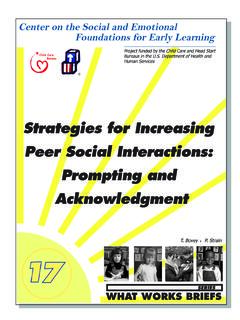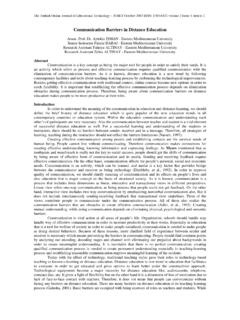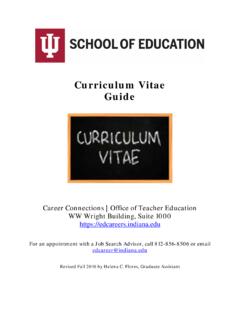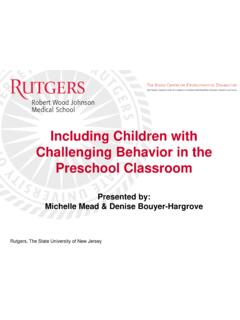Transcription of High-Leverage Practices in Special Education
1 McLeskey, J., Barringer, M-D., Billingsley, B., Brownell, M., Jackson, D., Kennedy, M., Lewis, T., Maheady, L., Rodriguez, J., Scheeler, M. C., Winn, J., & Ziegler, D. (2017, January). High-Leverage Practices in Special Education . Arlington, VA: Council for Exceptional Children & CEEDAR Center. 2017 CEC & CEEDAR 1 Effective Special Education teachers establish a consistent, organized, and respectful learning environment to support student success. To do this, they employ several Practices that are critical in promoting student social and emotional well-being.
2 First, effective teachers focus on increasing appropriate behavior by adopting an instructional approach that incorporates the explicit teaching of social skills and offers students multiple opportunities to practice appropriate social behaviors throughout the school day followed by positive specific feedback. Second, they implement evidence-based Practices to prevent social, emotional, and behavioral challenges and provide early intervention at the first sign of risk. Third, effective teachers provide increasingly comprehensive supports through a team-based problem-solving strategy, to match the intensity of student challenges guided by behavioral assessment.
3 Finally, they implement all behavioral supports even those in response to significant problem behavior in a caring, respectful, and culturally relevant manner. Effective teachers recognize that academic and behavioral support strategies are more effective when delivered within the context of positive and caring teacher student a consistent, organized, and respectful learning build and foster positive relationships, teachers should establish age-appropriate and culturally responsive expectations, routines, and procedures within their classrooms that are positively stated and explicitly taught and practiced across the school year.
4 When students demonstrate mastery and follow established rules and routines, teachers should provide age-appropriate specific performance feedback in meaningful and caring ways. By establishing, following, and reinforcing expectations of all students within the classroom, teachers will reduce the potential for challenging behavior and increase student engagement. When establishing learning environments, teachers should build mutually respectful relationships with students and engage them in setting the classroom climate ( , rules and routines); be respectful; and value ethnic, cultural, contextual, and linguistic diversity to foster student engagement across learning Practices : Research SynthesesHigh-Leverage Practicesin Special Education McLeskey, J.
5 , Barringer, M-D., Billingsley, B., Brownell, M., Jackson, D., Kennedy, M., Lewis, T., Maheady, L., Rodriguez, J., Scheeler, M. C., Winn, J., & Ziegler, D. (2017, January). High-Leverage Practices in Special Education . Arlington, VA: Council for Exceptional Children & CEEDAR Center. 2017 CEC & CEEDAR 2 Social/Emotional/ Behavioral Practices : Research SynthesesHigh-Leverage Practices in Special Education Special educators cannot make students learn or behave; they can, however, create environments to increase the likelihood that students do both (Lewis, 2009).
6 The foundation of any effective learning environment includes clear and consistent rules, routines, and procedures that keep students engaged and on track throughout the school day. All classroom procedures should be implemented in a proactive and positive manner in which the Special educator is always the exemplar in treating students and other adults in a respectful and caring manner. Rules should be stated positively ( , what the teacher wants students to do rather than does not want them to do) and kept to five or fewer.
7 Examples and non examples of behavioral expectations should be directly taught and expectations should be practiced throughout the school year until students demonstrate such as entering and exiting the classroom, how to respond to the teacher s attention signal, how to seek assistance, and expectations during activity transitions should be considered, as well as other daily routines. Critical steps to comply with procedures and routines should be task-analyzed and explicitly taught and practiced with students. The conventional recommended ratio found in the professional literature is for every corrective statement a teacher makes, educators should look for at least four opportunities to acknowledge appropriate behavior ( , student demonstrations of classroom expectations).
8 The goal is to acknowledge student mastery of social-behavioral expectations and compliance with procedures, not to point out frequent educators should provide students with opportunities to respond to both social and academic requests throughout the day, and prompts should reflect the nature of the academic or social expectation ( , who can tell me what voice level we use when we walk to lunch? ). The rate of opportunities to respond will vary across age and severity of disability, but should be a primary instructional strategy during acquisition and fluency building among all educators should strive for a balance of direct instruction, multiple opportunities for students to practice with high rates of feedback, and high rates of student success ( , 80% or better proficiency on tasks) to promote high engagement time and low rates of off-task behavior.
9 For every lesson, student learning progress should be carefully monitored and instruction, practice, and feedback adjusted SupportA clear body of evidence exists to support these classroom strategies, as well as several others (see Hattie, 2008, for a comprehensive review). Researchers have examined combinations of the above on both academic and social behavior effects (Armendariz & Umbreit, 1999; Blackwell & McLaughlin, 2005; Bowman-Perrott. 2009; McLeskey, J., Barringer, M-D., Billingsley, B., Brownell, M.)
10 , Jackson, D., Kennedy, M., Lewis, T., Maheady, L., Rodriguez, J., Scheeler, M. C., Winn, J., & Ziegler, D. (2017, January). High-Leverage Practices in Special Education . Arlington, VA: Council for Exceptional Children & CEEDAR Center. 2017 CEC & CEEDAR 3 Social/Emotional/ Behavioral Practices : Research SynthesesHigh-Leverage Practices in Special Education Haydon et al., 2010; Lewis, Hudson, Richter, & Johnson, 2004; Spencer, Scruggs, & Mastropieri, 2003; Sutherland, Wehby, & Yoder, 2002) and the essential features to increase teacher use of evidence-based Practices (Simonsen, Fairbanks, Briesch, Myers, & Sugai, 2008; Simonsen, Myers, & DeLuca, 2010; Stichter et al.







